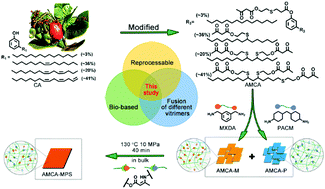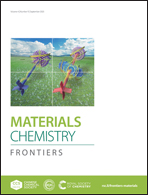Fusion of biobased vinylogous urethane vitrimers with distinct mechanical properties†
Abstract
As a class of recyclable thermoset, vitrimers are generally constructed by introducing dynamic chemistry into various synthetic or biobased building blocks. Particularly, biobased vitrimers have aroused increasing interest because of the utilization of renewable resources. The wide range of constructing resources and the different mechanical properties of the resulting networks highlight the fusion of vitrimers with distinct mechanical properties in the recycling process. However, most vitrimers have only been investigated in terms of their own reprocessability, or fusion of identical polymer networks. Herein, we report the concept of melding two biobased vinylogous urethane vitrimers with distinct mechanical properties. Two distinct biobased vinylogous urethane vitrimers were prepared by reacting acetoacetate-modified cardanol with two different diamines (MXDA or PACM). It was found that these vitrimers can be successfully fused and that, after three rounds of hot pressing, the mechanical and thermal properties of the fused vitrimer are comparable to that of a homogeneous vitrimer prepared using premixed MXDA and PACM diamines, the ratio of which is the same as the two distinct vitrimers. This capability of fusing two distinct vitrimers also features a flexible window for targeting mechanical properties, which can be achieved by simply adjusting the ratio of these two vitrimers.



 Please wait while we load your content...
Please wait while we load your content...